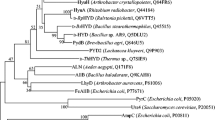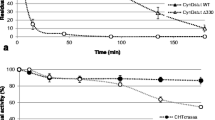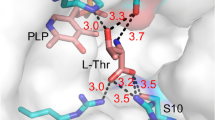Abstract
We previously reported that a deletion mutant (P478) with a residue Arg deleted at the C terminus of d-hydantoinase (P479) from Pseudomonas putida YZ-26 was dissociated into the monomer from its dimeric state. Based on the above result, a series of mutants of the enzyme with the C-terminal residues either deleted or substituted were prepared. The size-exclusion chromatography and bioactivity assay show that a C-terminal-substituted enzyme (R479D) and several truncated mutants (P478, P477, P476, and P475) are dissociated into the monomeric state as well, but their activities are largely retained. In contrast, two other mutants (R474 and R479A) are expressed in the form of random aggregates without any activity. Our experiments demonstrate that only the last four amino acids (-PVQR) at the C terminus of the enzyme can be deleted without seriously affecting its activity, although the enzyme is dissociated from a dimer into a monomer. These mutants also reveal some unique properties such as the enzymatic activity in vivo or in vitro, the effect of divalent metal ions, and the thermostability etc. in comparison to wild-type enzyme (P479). In addition, the three-dimensional structural modeling shows that the intact structure of the enzyme is essential, and the flexibility of the non-conservative region at the C terminus of the enzyme is quite limited.





Similar content being viewed by others
References
Shi, Y. W., Niu, L. X., Feng, X., & Yuan, J. M. (2006). Purification, enzymatic properties of a recombinant D-hydantoinase and its dissociation by zinc ion. World Journal of Microbiology and Biotechnology, 22, 675–680.
Shi, Y. W., Zhao, L. X., Niu, L. X., & Yuan, J. M. (2005). Gene sequence, soluble expression and homologous comparison of a D-Hydantoinase from Pseudomonas putida YZ-26. Chemical Research in Chinese University, 21, 552–557.
Niu, L. X., Zhang, X. Y., Shi Y. W., & Yuan, J. M. (2007). Subunit dissociation and stability alteration of D-Hydantoinase deleted at the terminal amino acid residue. Biotechnology Letters, 29, 303–308.
May, O., Siemann, M., Siemann, M. G., & Syldatk, C. (1998). Catalytic and structural function of zinc for the hydantoinase from Anthrobacter aurescens DSM 3745. Journal of Molecular Catalysis B, Enzymatic, 4, 211–218.
Ogawa, J., & Shimizu, S. (1999). Microbial enzymes: new industrial applications from traditional screening methods. Trends in Biotechnology, 17, 13–20.
Huang, C. Y., Chao, Y. P., & Yang, Y. S. (2003). Purification of industrial hydantoinase in one chromatographic step without affinity tag. Protein Expression and Purification, 30, 134–139.
Xu, Z., Liu, Y. Q., Yang, Y. L., Jiang, W. H., Arnold, E., & Ding, J. P. (2003). Crystal Structure of D-Hydantoinase from Burkholderia pickettii at a resolution of 2.7 angstroms: Insights into the molecular basis of enzyme thermostability. Journal of Bacteriology, 185, 4038–4049.
Abendroth, J., Niefind, K., & Schomburg, D. (2002). X-ray structure of a Dihydropyrimidinase from Thermus sp. at 1.3 Å resolution. Journal of Molecular Biology, 320, 143–156.
Abe, I., Abe, T., Lou, W. W., Masuola, T., & Noguchi, H. (2007). Site-directed mutagenesis of conserved aromatic residues in rat squalene epoxidase. Biochemical and Biophysical Research Communications, 352, 259–263.
Villadsen, D., & Nielsen, T. H. (2001). N-terminal truncation affects the kinetics and structure of fructose-6-phosphate 2-kinase/fructose-2,6-bisphosphatase from Arabidopsis thaliana. Biochemical Journal, 359, 591–597.
Cheon, Y. H., Park, H. S., Lee, S. C., Lee, D. E., & Kim, H. S. (2003). Structure-based mutational analysis of the active site residues of d-hydantoinase. Journal of Molecular Catalysis. B, Enzymatic, 26, 217–222.
Kim, G. J., & Kim, H. S. (1998). C-Terminal Regions of D-Hydantoinases are nonessential for catalysis, but affect the oligomeric structure. Biochemical and Biophysical Research Communications, 243, 96–100.
Laemmli, U. (1970). Cleavage of structural proteins during the assembly of bacteriophage T4. Nature, 227, 680–685.
Schwede, T., Kopp, J., Guex, N., & Peitsch, M. C. (2003). SWISS-MODEL: an automated protein homology-modeling server. Nucleic Acids Research, 31, 3381–3385.
Gerlt, J. A., & Raushel, F. M. (2003). Evolution of function in (β/α)8-barrel enzymes. Current Opinion in Chemical Biology, 7, 252–264.
Lohkamp, B., Andersen, B., Piskur, J., & Dobritzsch D. (2006). The crystal structures of dihydropyrimidinases reaffirm the close relationship between cyclic amidohydrolases and explain their substrate specificity. Journal of Biological Chemistry, 281, 13762–13776.
Cheon, Y. H., Kim, H. S., Han, K. H., Abendroth, J., Niefind, K., Schomburg, D., et al. (2002). Crystal structure of D-Hydantoinase from Bacillus stearothermophilus: Insight into the stereochemistry of enantioselectivity. Biochemist, 41, 9410–9417.
Radha Kishan, K. V., Vohra, R. M., Ganesan, K., Agrawal, V., Sharma, V. M., & Sharma, R. (2005). Molecular structure of D-Hydantoinase from Bacillus sp. AR9: Evidence for Mercury inhibition. Journal of Molecular Biology, 347, 95–105.
Skoulakis, S., & Goodfellow, J. M. (2003). The pH-dependent stability of wild-type and mutant Transthyretin Oligomers. Biophysical Journal, 84, 2795–2804.
Mei, Y. Z., He, B. F., & Ouyang, P. K. (2005). Progress in study on thermostability and substrate specificity of hydantoinase. Chinese Journal of Bioprocess Engineering, 3, 24–28.
Holm, L., & Sander, C. (1997). An evolutionary treasure: Unification of a broad set of Amidohydrolases related to urease. Proteins: Structure, Function and Genetics 28, 72–82.
Acknowledgments
The authors wish to thank the National Science Foundation of Shanxi Province (NSFSX, 031042), China for this research support. We gratefully acknowledge the valuable discussion with Dr. Tao Yuan from Sanofi Pasteur, Canada.
Author information
Authors and Affiliations
Corresponding author
Rights and permissions
About this article
Cite this article
Zhang, XY., Niu, LX., Shi, YW. et al. The Flexibility of the Non-Conservative Region at the C Terminus of d-Hydantoinase from Pseudomonas putida YZ-26 is Extremely Limited. Appl Biochem Biotechnol 144, 237–247 (2008). https://doi.org/10.1007/s12010-007-8004-3
Published:
Issue Date:
DOI: https://doi.org/10.1007/s12010-007-8004-3




